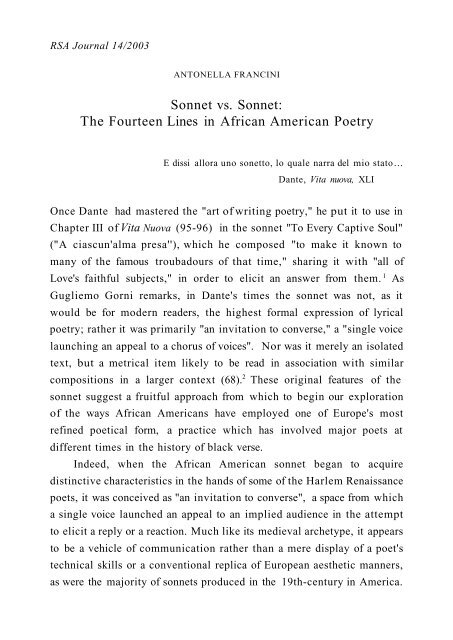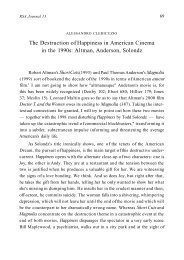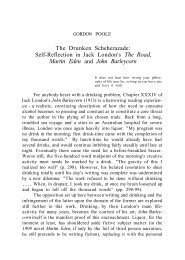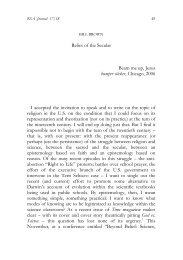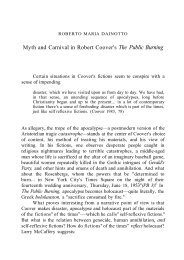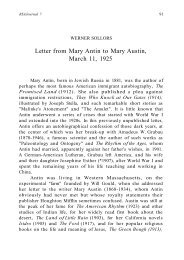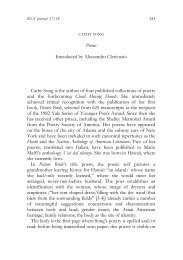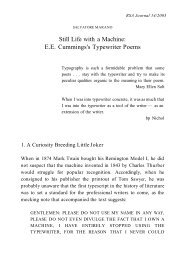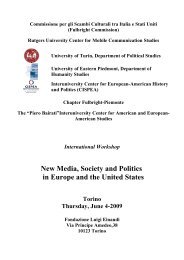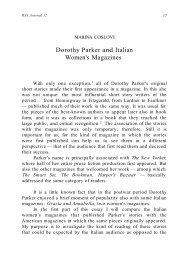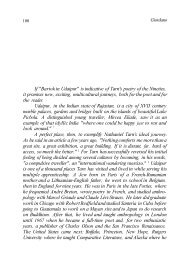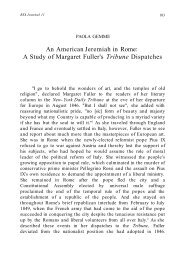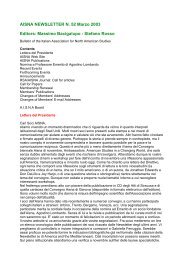Sonnet vs. Sonnet: The Fourteen Lines in African American Poetry
Sonnet vs. Sonnet: The Fourteen Lines in African American Poetry
Sonnet vs. Sonnet: The Fourteen Lines in African American Poetry
You also want an ePaper? Increase the reach of your titles
YUMPU automatically turns print PDFs into web optimized ePapers that Google loves.
RSA Journal 14/2003<br />
ANTONELLA FRANCINI<br />
<strong>Sonnet</strong> <strong>vs</strong>. <strong>Sonnet</strong>:<br />
<strong>The</strong> <strong>Fourteen</strong> <strong>L<strong>in</strong>es</strong> <strong>in</strong> <strong>African</strong> <strong>American</strong> <strong>Poetry</strong><br />
E dissi allora uno sonetto, lo quale narra del mio stato...<br />
Dante, Vita nuova, XLI<br />
Once Dante had mastered the "art of writ<strong>in</strong>g poetry," he put it to use <strong>in</strong><br />
Chapter III of Vita Nuova (95-96) <strong>in</strong> the sonnet "To Every Captive Soul"<br />
("A ciascun'alma presa''), which he composed "to make it known to<br />
many of the famous troubadours of that time," shar<strong>in</strong>g it with "all of<br />
Love's faithful subjects," <strong>in</strong> order to elicit an answer from them. 1 As<br />
Gugliemo Gorni remarks, <strong>in</strong> Dante's times the sonnet was not, as it<br />
would be for modern readers, the highest formal expression of lyrical<br />
poetry; rather it was primarily "an <strong>in</strong>vitation to converse," a "s<strong>in</strong>gle voice<br />
launch<strong>in</strong>g an appeal to a chorus of voices". Nor was it merely an isolated<br />
text, but a metrical item likely to be read <strong>in</strong> association with similar<br />
compositions <strong>in</strong> a larger context (68). 2 <strong>The</strong>se orig<strong>in</strong>al features of the<br />
sonnet suggest a fruitful approach from which to beg<strong>in</strong> our exploration<br />
of the ways <strong>African</strong> <strong>American</strong>s have employed one of Europe's most<br />
ref<strong>in</strong>ed poetical form, a practice which has <strong>in</strong>volved major poets at<br />
different times <strong>in</strong> the history of black verse.<br />
Indeed, when the <strong>African</strong> <strong>American</strong> sonnet began to acquire<br />
dist<strong>in</strong>ctive characteristics <strong>in</strong> the hands of some of the Harlem Renaissance<br />
poets, it was conceived as "an <strong>in</strong>vitation to converse", a space from which<br />
a s<strong>in</strong>gle voice launched an appeal to an implied audience <strong>in</strong> the attempt<br />
to elicit a reply or a reaction. Much like its medieval archetype, it appears<br />
to be a vehicle of communication rather than a mere display of a poet's<br />
technical skills or a conventional replica of European aesthetic manners,<br />
as were the majority of sonnets produced <strong>in</strong> the 19th-century <strong>in</strong> America.
38 Antonella Franc<strong>in</strong>i<br />
In outl<strong>in</strong><strong>in</strong>g a history of the <strong>African</strong> <strong>American</strong> sonnet, then, one does well<br />
to beg<strong>in</strong> from this turn<strong>in</strong>g po<strong>in</strong>t <strong>in</strong> its evolution — the Harlem<br />
Renaissance period — when, once they had mastered "the art of writ<strong>in</strong>g<br />
poetry," certa<strong>in</strong> black poets moved away from the norm, and gave this<br />
metrical form new vitality. In mak<strong>in</strong>g it one of their chosen modes of<br />
expression, these poets succeeded <strong>in</strong> recover<strong>in</strong>g the sonnet's orig<strong>in</strong>al<br />
function centuries after its birth and with<strong>in</strong> a very different cultural<br />
sett<strong>in</strong>g. In their hands, the fourteen-l<strong>in</strong>e structure turns <strong>in</strong>to an ideal<br />
forum, a public space for dynamic argumentation of social and political<br />
themes directed to a specific category of readers.<br />
A case <strong>in</strong> po<strong>in</strong>t is the celebrated 1919 poem "If We Must Die," by<br />
Claude McKay, one of the lead<strong>in</strong>g figures of the Harlem Renaissance and<br />
the author of a significant number of sonnets built around the <strong>African</strong><br />
<strong>American</strong> experience:<br />
If we must die, let it not be like hogs<br />
Hunted and penned <strong>in</strong> an <strong>in</strong>glorious spot,<br />
While round us bark the mad and hungry dogs,<br />
Mak<strong>in</strong>g their mock at our accursèd lot.<br />
If we must die, O let us nobly die,<br />
So that our precious blood may not be shed<br />
In va<strong>in</strong>; then even the monsters we defy<br />
Shall be constra<strong>in</strong>ed to honor us though dead!<br />
o k<strong>in</strong>smen! we must meet the common foe!<br />
Though far outnumbered let us show us brave,<br />
And for their thousand blows deal one death- blow!<br />
What though before us lies the open grave?<br />
Like men we'll face the murderous, cowardly pack,<br />
Pressed to the wall, dy<strong>in</strong>g, but fight<strong>in</strong>g back. 3<br />
Divided <strong>in</strong>to three quatra<strong>in</strong>s and a clos<strong>in</strong>g rhym<strong>in</strong>g couplet, the poem is<br />
formally an English sonnet tightly constructed around an idea (if we
<strong>The</strong> <strong>Fourteen</strong> <strong>L<strong>in</strong>es</strong> <strong>in</strong> <strong>African</strong>-<strong>American</strong> <strong>Poetry</strong><br />
must die, let us die with honor), which the poet develops <strong>in</strong> the first two<br />
parts. <strong>The</strong> hypothetical premise repeated at the beg<strong>in</strong>n<strong>in</strong>g of l<strong>in</strong>es 1 and<br />
5 l<strong>in</strong>ks these two sections through a dexterous handl<strong>in</strong>g of grammar and<br />
diction. <strong>The</strong> shift from the negative subjunctive <strong>in</strong> the second hemistich<br />
of the first l<strong>in</strong>e ("let it not be like hogs") to the affirmative <strong>in</strong> l<strong>in</strong>e 5 ("O<br />
let us nobly die") <strong>in</strong>dicates a progression from fear to bravery, from<br />
passivity to action, from "an <strong>in</strong>glorious spot" to a noble position. <strong>The</strong><br />
imagery <strong>in</strong> these two quatra<strong>in</strong>s also marks a shift of focus: <strong>in</strong> the first two<br />
l<strong>in</strong>es of each one the speaker exhorts his companions to revolt, while <strong>in</strong><br />
the last two he calls attention to the oppressors. Plac<strong>in</strong>g the volta at l<strong>in</strong>e<br />
9, <strong>in</strong>stead of at l<strong>in</strong>e 13 as an English sonnet would do, is another sign of<br />
McKay's skilful handl<strong>in</strong>g of the sonnet form. <strong>The</strong> turn <strong>in</strong> fact signals the<br />
abandonment of the symmetrical structure and the hypothetical form,<br />
thus unbalanc<strong>in</strong>g the pace of the poem, as if he now <strong>in</strong>tended to mimic<br />
the turmoil of an actual fight. Moreover, the thought <strong>in</strong> the third<br />
quatra<strong>in</strong> is fractured by the strong caesura at the beg<strong>in</strong>n<strong>in</strong>g of l<strong>in</strong>e 9, by<br />
the irregular accents, and by l<strong>in</strong>e 12, which appears to be separated from<br />
the previous three l<strong>in</strong>es, be<strong>in</strong>g <strong>in</strong> fact a bridge to the clos<strong>in</strong>g couplet. <strong>The</strong><br />
structure of a Petrarchan sonnet looms beh<strong>in</strong>d the English one, with the<br />
sestet resolv<strong>in</strong>g what the octave has projected: the <strong>in</strong>evitable clash of the<br />
<strong>in</strong>human "cowardly pack" with the speaker's k<strong>in</strong>smen and their certa<strong>in</strong>,<br />
yet honorable, death. <strong>The</strong> alternate rhyme scheme further confirms the<br />
rhetorical framework of the sonnet: "hogs" connected with "dogs"<br />
underl<strong>in</strong>es the bestial nature of the persecutors, while "<strong>in</strong>glorious spot"<br />
rhym<strong>in</strong>g with "accursed lot" rem<strong>in</strong>ds the reader of the condition of the<br />
speaker's community; social resurrection through fight<strong>in</strong>g and death is<br />
stressed by the rhymes "die-defy", "shed-dead", "foe-deathblow", and<br />
"brave-grave"; and the contrast between humanity and brutality is f<strong>in</strong>ally<br />
restated <strong>in</strong> the couplet, where the "fight<strong>in</strong>g back" of the oppressed men<br />
is opposed to the "cowardly pack" of the oppressors.<br />
Thus, a tactful handl<strong>in</strong>g of both technique and ideology guarantees<br />
39
40 Antonella Franc<strong>in</strong>i<br />
the poem's effectiveness. <strong>The</strong> space of the sonnet is <strong>in</strong>habited by the<br />
dissent<strong>in</strong>g voice of the black poet, who challenges the tradition this form<br />
stands for, replac<strong>in</strong>g the love theme with an open attack on Western<br />
culture, its contradictions and hypocrisies. Moreover, it should be noted<br />
that, although written aga<strong>in</strong>st the backdrop of the black urban upris<strong>in</strong>g<br />
across the United States <strong>in</strong> summer 1919, 4 McKay's poem does not<br />
identify the fight<strong>in</strong>g groups, thus achiev<strong>in</strong>g a resonance that goes beyond<br />
the <strong>American</strong> context. In his hands, the tight cage of the sonnet<br />
ultimately turns <strong>in</strong>to a dynamic vehicle for freedom and social justice. 5<br />
As has been noticed, 6 the poem echoes the most famous speech <strong>in</strong><br />
Shakespeare's Henry V (Act IV, Scene III), <strong>in</strong> which, prior to the battle<br />
ofAg<strong>in</strong>court, the k<strong>in</strong>g exhorts his troops to fight bravely and with honor<br />
aga<strong>in</strong>st the overwhelm<strong>in</strong>g force of the French army. McKay exploits the<br />
episode, adapt<strong>in</strong>g its mode and diction to the racial violence <strong>in</strong> America,<br />
as evidenced by my italics <strong>in</strong> the follow<strong>in</strong>g l<strong>in</strong>es: "If we are marked to die,<br />
we are enow / To do our country loss; and if we live, / <strong>The</strong> fewer men, the<br />
greater share ofhonor ... For he to-day that sheds his blood with me / Shall<br />
be my brother ... And gentlemen <strong>in</strong> England now a-bed / Shall th<strong>in</strong>k<br />
themselves accurs'd they were not here..." 7 This <strong>in</strong>tertextual relation with<br />
Shakespeare's play not only conveys the speaker's trust <strong>in</strong> the victory of<br />
the oppressed over the oppressors (as Henry V's outnumbered army won<br />
over the French), but it also shows that the language of the European<br />
literary tradition can be appropriated by the black poet to construct new<br />
circuits ofmean<strong>in</strong>g. McKay's exploitation of this language performs what<br />
Ralph Ellison was to call "a technical assault aga<strong>in</strong>st the styles which<br />
have gone before" (183) as a form ofprotest <strong>in</strong> art that does not, however,<br />
necessarily espouse a specific political or social program.<br />
In another McKay sonnet, "Birds of Prey," the Petrarchan form is<br />
comb<strong>in</strong>ed with imagery that recalls the passages <strong>in</strong> Milton's Paradise Lost<br />
where Satan is likened to a predatory bird ready to destroy Adam and<br />
Eve's harmony <strong>in</strong> Eden:
<strong>The</strong> <strong>Fourteen</strong> <strong>L<strong>in</strong>es</strong> <strong>in</strong> <strong>African</strong>-<strong>American</strong> <strong>Poetry</strong><br />
<strong>The</strong>ir shadow dims the sunsh<strong>in</strong>e of our day,<br />
As they go lumber<strong>in</strong>g across the sky,<br />
Squawk<strong>in</strong>g <strong>in</strong> joy of feel<strong>in</strong>g safe on high,<br />
Beat<strong>in</strong>g their heavy w<strong>in</strong>gs of owlish gray.<br />
<strong>The</strong>y scare the s<strong>in</strong>g<strong>in</strong>g birds of the earth away<br />
As, greed-impelled, they circle threaten<strong>in</strong>gly,<br />
Watch<strong>in</strong>g the toilers with malignant eye,<br />
From their exclusive haven — birds of prey.<br />
<strong>The</strong>y swoop down for the spoil <strong>in</strong> certa<strong>in</strong> might,<br />
And fasten <strong>in</strong> our bleed<strong>in</strong>g flesh their claws.<br />
<strong>The</strong>y beat us to surrender weak with freight.<br />
And tugg<strong>in</strong>g and tear<strong>in</strong>g without let or pause,<br />
<strong>The</strong>y flap their hideous w<strong>in</strong>gs <strong>in</strong> grim delight,<br />
And stuff our gory hearts <strong>in</strong>to their maws. (174)<br />
Here is Book III, l<strong>in</strong>es 431-441, of Milton's poem, where Satan is<br />
bent like a vulture on his <strong>in</strong>nocent prey:<br />
As when a vulture, on Imaus bred,<br />
Whose snowy ridge of rov<strong>in</strong>g Tartar bounds,<br />
Dislodg<strong>in</strong>g from a region scarce of prey<br />
To gorge the flesh of lambs or yeanl<strong>in</strong>g kids<br />
On hills where flocks are fed, flies toward the spr<strong>in</strong>gs<br />
Of Ganges or H ydaspes, Indian streams,<br />
So, on this w<strong>in</strong>dy sea of land, the Fiend<br />
Walked up and down alone bent on his prey...<br />
<strong>The</strong> posture of Milton's hero is echoed <strong>in</strong> McKay's l<strong>in</strong>es; once aga<strong>in</strong><br />
he <strong>in</strong>troduces a political theme by borrow<strong>in</strong>g and manipulat<strong>in</strong>g material<br />
from the tradition of the dom<strong>in</strong>at<strong>in</strong>g culture. <strong>The</strong> contrast between evil<br />
forces, associated with dark tonalities, and their victims, associated with<br />
41
42 Antonella Franc<strong>in</strong>i<br />
the light ("sunsh<strong>in</strong>e" and "s<strong>in</strong>g<strong>in</strong>g birds"), established by McKay <strong>in</strong> the<br />
octave of his sonnet, f<strong>in</strong>ds its resolution at the end of l<strong>in</strong>e 8, when the<br />
om<strong>in</strong>ous shadows described above become "birds of prey," mark<strong>in</strong>g the<br />
volta of the poem. In the sestet the contrast between good and evil<br />
precipitates <strong>in</strong>to bloodshed, vividly outl<strong>in</strong>ed by the speaker, himself a<br />
victim <strong>in</strong> the bloody clash. In this case, too, McKay's usage of personal<br />
pronouns ("them" versus "us") makes the sonnet resound beyond the<br />
<strong>American</strong> historical context, creat<strong>in</strong>g a poetical space with<strong>in</strong> which<br />
power structures are challenged and the contradictions of modern<br />
democracies disclosed. <strong>The</strong> ma<strong>in</strong> trope the poet uses here — the w<strong>in</strong>gs of<br />
birds ofprey — also recalls the image of the eagle, the emblem of empires<br />
<strong>in</strong> Western culture, from classical Rome to the United States. 8<br />
Elsewhere Milton's hero serves McKay <strong>in</strong> his portrayal of the<br />
exclusion of blacks from their country's bounty and beauty and the<br />
consequent nourishment of hate and resentment that is their dest<strong>in</strong>y. See,<br />
for example, the sonnets "<strong>The</strong> White House," "<strong>The</strong> White City," and<br />
"America." "Outcast" is another sonnet where McKay portrays the black<br />
as "a ghost," "a th<strong>in</strong>g apart" and "out of time" because, we read, he is<br />
born "far from [his] native clime" and "[s]ometh<strong>in</strong>g <strong>in</strong> [him] is lost, for<br />
ever lost, / Some vital th<strong>in</strong>g has gone out of [his] heart." <strong>The</strong> turn<strong>in</strong>g<br />
po<strong>in</strong>t is <strong>in</strong> the second quatra<strong>in</strong>, where the black's hybrid cultural identity<br />
is acknowledged: "I would go back to darkness and to peace, / But the<br />
great western world holds me <strong>in</strong> fee, / And I may never hope for full<br />
release / While to its alien gods I bend my knee" (173). Among these<br />
"alien gods" there are the makers of the Western tradition and its forms,<br />
which are, as we have seen, <strong>in</strong>extricably woven <strong>in</strong>to the language of<br />
MacKay's sonnets, just as he is <strong>in</strong>extricably rooted <strong>in</strong> the Western culture<br />
that holds him "<strong>in</strong> fee."<br />
In other sonnets, McKay draws material from Christian imagery and<br />
diction <strong>in</strong> order to address directly the God that is the poet's silent<br />
<strong>in</strong>terlocutor, whom he questions about the reasons for human behavior
<strong>The</strong> <strong>Fourteen</strong> <strong>L<strong>in</strong>es</strong> <strong>in</strong> <strong>African</strong>-<strong>American</strong> <strong>Poetry</strong><br />
and whom he asks for sustenance. In the poem "Truth" he borrows<br />
Pilate's unanswered question to Jesus <strong>in</strong> the Gospel of St. John ("But<br />
what is Truth?") to weave a discourse on the elusiveness of the term:<br />
Oh, what is Truth? So Pilate asked <strong>The</strong>e, Lord,<br />
Two thousand years when Thou wert manifest,<br />
As the Eternal and Incarnate Word,<br />
Chosen of God and by Him s<strong>in</strong>gly blest:<br />
In this vast world of lies and hate and greed,<br />
Upon my knees, Oh Lord, for Truth I plead. (272)<br />
In such texts the Gospel tradition meets with the sonnet form, which<br />
appears a suitable narrative space for develop<strong>in</strong>g themes and images<br />
rem<strong>in</strong>iscent of <strong>African</strong> <strong>American</strong> folklore, the rhyme scheme and the<br />
implied musical accompaniment be<strong>in</strong>g another po<strong>in</strong>t of contact. In<br />
conclusion, the sonnet form is a mirror <strong>in</strong> which the <strong>African</strong> <strong>American</strong><br />
poet's self and heritage are reflected: the colonized subject, hav<strong>in</strong>g lost<br />
forever his or her orig<strong>in</strong>al identity, <strong>in</strong>terprets and reconstruct the colonizer's<br />
language and cultural patterns accord<strong>in</strong>g to his or her marg<strong>in</strong>alized<br />
perspective. That out of this a new eloquence is developed is not, <strong>in</strong><br />
Tzvetan Todorov's words apropos of historical <strong>in</strong>terpretations, "a<br />
superfluous ornament, but the mark of a greater 'truth-disclosure'" (140).<br />
<strong>The</strong> sonnets of Countee Cullen, the other well-known Harlem<br />
Renaissance sonneteer, are fashioned <strong>in</strong> a manner similar to McKay's. 9<br />
Whether they follow the English or the Italian model, or are a<br />
comb<strong>in</strong>ation of both, they also stand out as literary forums for the black<br />
poet to address a social <strong>in</strong>iquity, and <strong>in</strong>vite the reader to react. <strong>The</strong> fact<br />
that both the Jamaican-born McKay and Cullen were steeped <strong>in</strong> British<br />
poetry from early on expla<strong>in</strong>s only <strong>in</strong> part their adoption of traditional<br />
forms. <strong>The</strong>ir recovery of formal poetry just at the time when free verse<br />
was shap<strong>in</strong>g the new poetry of the 20th century, and theories about the<br />
43
44 Antonella Franc<strong>in</strong>i<br />
impersonality and the objectivity of art predom<strong>in</strong>ated, responds to an<br />
<strong>in</strong>tentional strategy and accounts, as Carol Miller suggested, for "an<br />
alternative modernist consciousness" (51). 10 Tradition is resumed,<br />
appropriated and subverted by a strong poetical subject who transforms the<br />
established lyrical canons <strong>in</strong>to what Adrienne Rich calls "a rebellious cry",<br />
"a poetics of resistance" (2).<br />
[A]lthough very conscious of the new criticism and trends <strong>in</strong> poetry, to which<br />
I am keenly responsive and receptive [McKay wrote <strong>in</strong> a prefatory note to his<br />
1922 collection Harlem Shadows], I have adhered to such of the older traditions<br />
as I f<strong>in</strong>d adequate for my most lawless and revolutionary passions and moods<br />
... I have not hesitated to use words which are old, and <strong>in</strong> some circles<br />
considered poetically overworked and dead, when I thought I could make them<br />
glow alive by new manipulation. (Harlem xx)<br />
Such 'manipulation' was not new <strong>in</strong> black verse. As far back as the<br />
18th century, Phyllis Wheatley <strong>in</strong>augurated this technique <strong>in</strong>sert<strong>in</strong>g<br />
racial motifs <strong>in</strong> the European-derived metrical constructions collected <strong>in</strong><br />
her only volume, Poems on Various Subjects Religious and Moral (1773).<br />
Texts such as "To the Right Honorable William, Earl of Dartmouth, His<br />
Majesty's Pr<strong>in</strong>cipal Secretary of State for North-America, &c" and "On<br />
Be<strong>in</strong>g Brought from Africa to America," firmly based on British models,<br />
show awareness of the condition of slavery. In stanza four of the former<br />
poem, she develops her political discourse about New England's freedom<br />
from Great Brita<strong>in</strong> draw<strong>in</strong>g on her personal experience: "Should you, my<br />
lord, while you peruse my song, / Wonder from whence my love of<br />
Freedom sprung, / ... I, young <strong>in</strong> life, by seem<strong>in</strong>g cruel fate / Was snatch'd<br />
from A/ric's fancy'd happy seat ..." (82). 11 And when the sonnet entered<br />
<strong>African</strong> <strong>American</strong> poetry <strong>in</strong> the n<strong>in</strong>eteenth century, 12 two major black<br />
sonneteers, Henrietta Cordelia Ray and Paul Laurence Dunbar, made a<br />
first attempt at graft<strong>in</strong>g racial themes onto the fourteen l<strong>in</strong>es. Here is the
<strong>The</strong> <strong>Fourteen</strong> <strong>L<strong>in</strong>es</strong> <strong>in</strong> <strong>African</strong>-<strong>American</strong> <strong>Poetry</strong><br />
open<strong>in</strong>g of Ray's tribute to "Robert G. Shaw," commander <strong>in</strong> chief of an<br />
<strong>African</strong> <strong>American</strong> regiment at the battle of Fort Wagner dur<strong>in</strong>g the Civil<br />
War, followed by the beg<strong>in</strong>n<strong>in</strong>g of Dunbar's eulogy of Frederick<br />
Douglass:<br />
When War's red banners trailed along the sky,<br />
And many a manly heart grew all aflame<br />
With patriotic love and purest aim,<br />
<strong>The</strong>re rose a noble soul who dared to die,<br />
If only Right could w<strong>in</strong>. He heard the cry<br />
Of struggl<strong>in</strong>g bondmen and he quickly came ... 13<br />
Ah, Douglass, we have fallen on evil days,<br />
Such days' as thou, not even thou didst know,<br />
When thee, the eyes of that harsh long ago<br />
Saw, salient, at the cross of devious ways,<br />
And all the country heard thee with amaze ... 14<br />
Like all of the numerous impeccable Italian sonnets <strong>in</strong> Ray's portrait<br />
gallery of public and private figures, this one too is narrated from the<br />
outside <strong>in</strong> a voice which sounds detached from her subject matter,<br />
controlled as it is by a sense of decorum and deep reverence for the<br />
adopted metrical form and poetic tradition. Dunbar's voice, <strong>in</strong>stead,<br />
immediately appears <strong>in</strong>volved <strong>in</strong> the issue of slavery, as the "we" <strong>in</strong> the<br />
first l<strong>in</strong>e <strong>in</strong>dicates. Yet, as Marcellus Blount argues, "even the most<br />
dar<strong>in</strong>g of [Ray's and Dunbar's] poems are cautious; the freedom they<br />
achieve somewhat constra<strong>in</strong>t" (232), s<strong>in</strong>ce the voice of each poet is<br />
covered by the literacy and gender conventions of the form itself and by<br />
the tradition <strong>in</strong>herited from <strong>African</strong> <strong>American</strong> political discourse. Still,<br />
these early examples allow us to observe a sort of pre-history of the black<br />
sonnet, a necessary apprenticeship provid<strong>in</strong>g the background for the<br />
45
46 Antonella Franc<strong>in</strong>i<br />
poets of the next generation who renewed the form. Moreover, these early<br />
poets' series of tributes to admired figures, <strong>in</strong>clud<strong>in</strong>g leaders of <strong>African</strong><br />
<strong>American</strong> history, provide an <strong>in</strong>terest<strong>in</strong>g prototype for the sonnet<br />
sequences and long poems made up of stanza-like sonnets which post<br />
modern and contemporary black poets have created <strong>in</strong> their attempt to<br />
develop a modern eloquence out of tradition, propose an alternative<br />
<strong>in</strong>terpretation of this tradition, and come to terms with its complex<br />
relationship with race.<br />
Gwendolyn Brooks employed the sonnet form <strong>in</strong> her early poetry,<br />
especially <strong>in</strong> her first collections, A Street <strong>in</strong> Bronzeville (1945) and Annie<br />
Allen (1949). <strong>The</strong> last section of the former is a cycle of twelve sonnets<br />
entitled "Gay Chaps At the Bar" — a "souvenir", as the dedication<br />
declares, for the author's brother, Staff Sergeant Raymond Brooks, active<br />
<strong>in</strong> World War II, and for every other soldier (Blacks 64). Here are Brooks's<br />
words on the poems' genesis:<br />
I first wrote the one sonnet, without th<strong>in</strong>k<strong>in</strong>g of extensions. I wrote it because<br />
of a letter I got from a soldier who <strong>in</strong>cluded that phrase (the title of the series<br />
of twelve sonnets and of the first sonnet) <strong>in</strong> what he was tell<strong>in</strong>g me; and then<br />
I said, there are other th<strong>in</strong>gs to say about what's go<strong>in</strong>g on at the front and all,<br />
and I'll write more poems, some of them based on the stuff of letters that I was<br />
gett<strong>in</strong>g from several soldiers, and I felt it would be good to have them all <strong>in</strong><br />
the same form, because it would serve my purpose throughout. (Report 158)<br />
Words from that first letter by Lieutenant William Couch stationed <strong>in</strong><br />
the South Pacific are quoted <strong>in</strong> the epigraph ("and guys I knew <strong>in</strong> the<br />
States, young officers, return from the front cry<strong>in</strong>g and trembl<strong>in</strong>g. Gay<br />
chaps at the bar <strong>in</strong> Los Angeles, Chicago, New York"), thus <strong>in</strong>troduc<strong>in</strong>g<br />
the theme of the sequence — a somber meditation on war by black (and<br />
white) soldiers whose experience <strong>in</strong> combat has turned their youthful<br />
cheerfulness <strong>in</strong>to fear, their hopes <strong>in</strong>to sorrow and doubt. Ghost-like, the
<strong>The</strong> <strong>Fourteen</strong> <strong>L<strong>in</strong>es</strong> <strong>in</strong> <strong>African</strong>-<strong>American</strong> <strong>Poetry</strong><br />
letter format stands beh<strong>in</strong>d these pieces, each one narrated by a different<br />
voice so that the entire cycle ultimately sounds polyphonic. <strong>The</strong> poet<br />
directs the soldiers' voices with mastery, channel<strong>in</strong>g them <strong>in</strong>to a unified<br />
work <strong>in</strong> which the chaps' words may cont<strong>in</strong>ue to bear witness, mov<strong>in</strong>g<br />
from the private sphere ofthe letter to the public forum ofpoetry. Indeed,<br />
Brooks's pseudo record of others' testimony is a very ref<strong>in</strong>ed literary<br />
operation, aim<strong>in</strong>g at wedd<strong>in</strong>g the <strong>in</strong>dividual history of her "corres<br />
pondents" with ma<strong>in</strong>stream Western culture. In her macro-text, the<br />
twelve sonnets take on the role of stanzas, yet each reta<strong>in</strong>s its <strong>in</strong>tegrity as<br />
an <strong>in</strong>dependent poem <strong>in</strong>habited by a dist<strong>in</strong>ctive voice.<br />
Like its medieval archetypes, Brooks's sequence achieves unity by<br />
address<strong>in</strong>g a s<strong>in</strong>gle theme, us<strong>in</strong>g specific metrical choices, and through<br />
repetitions of key words. <strong>The</strong> number twelve itself is rem<strong>in</strong>iscent of<br />
authoritative 13th- and 14th-century models of such cycles as Folgore da<br />
San Gimignano's sonnets on the months. "Gay Chaps" can <strong>in</strong> fact be read<br />
as a temporal sequence — a fictional year dur<strong>in</strong>g which the soldiers'<br />
<strong>in</strong>nocence surrenders to experience. In any case, Brooks also br<strong>in</strong>gs us to<br />
the heart of the European lyric tradition, mediated once aga<strong>in</strong> by the<br />
sonnet sequences of the English Renaissance, from Shakespeare's to John<br />
Donne's. 15 Yet her brief "canzoniere" is, <strong>in</strong> her own words, "a sonnet series<br />
<strong>in</strong> off-rhyme" for "an off-rhyme situation" (Report 158). It stems, one<br />
might say, from the poet's negotiation with tradition, history, and her<br />
own perspective as an <strong>African</strong> <strong>American</strong> poet who claims a historically<br />
active, if not political, role for poetry.<br />
<strong>The</strong> first sonnet <strong>in</strong> the cycle (Blacks 64-75) beautifully <strong>in</strong>troduces all<br />
these themes:<br />
We knew how to order. Just the dash<br />
Necessary. <strong>The</strong> length of gaiety <strong>in</strong> good taste.<br />
Whether the raillery should be slightly iced<br />
And given green, or served up hot and lush.<br />
47
48 Antonella Franc<strong>in</strong>i<br />
And we knew beautifully how to give to women<br />
<strong>The</strong> summer spread, the tropics, of our love.<br />
When to persist, or hold a hunger off.<br />
Knew white speech. How to make a look an omen.<br />
But noth<strong>in</strong>g ever taught us to be islands.<br />
And smart, athletic language for this hour<br />
Was not <strong>in</strong> the curriculum. No stout<br />
Lesson showed how to chat with death. We brought<br />
No brass fortissimo, among our talents,<br />
To holler down the lions <strong>in</strong> this air.<br />
Follow<strong>in</strong>g the model of the Petrarchan sonnet, this poem comes alive<br />
thanks to the license the poet takes. Abandon<strong>in</strong>g both a rigorous rhyme<br />
scheme and strict iambic pentameter metrics, Brooks calibrates<br />
assonances, alliterations, slant-rhymes, accents, enjambments and<br />
punctuation <strong>in</strong> order to create language <strong>in</strong> motion, language <strong>in</strong> the<br />
mak<strong>in</strong>g on the page, thereby mimick<strong>in</strong>g the thought process of the<br />
speaker. Speak<strong>in</strong>g through a collective "we," the soldier enumerates <strong>in</strong><br />
the octave a black man's resources vis-à-vis war and death, each<br />
emphasized by a careful distribution of accents which make the voice rise<br />
when knowledge is deployed. <strong>L<strong>in</strong>es</strong> 1 and 8 beg<strong>in</strong> appropriately with a<br />
spondaic rhythm. L<strong>in</strong>e 5 reiterates the accented verb "knew," which<br />
rhymes, as has been noticed, 16 with the first stressed syllable of<br />
"beautifully," thus reach<strong>in</strong>g a heightened effect by the position of these<br />
two words, placed as they are at the junction between anapest and dactyl.<br />
Such technique characterizes Brooks's prosody, as she plays with stressed<br />
and unstressed syllables also to control the length of the l<strong>in</strong>es,<br />
constructed to match the speaker's revelation of the blacks' strategies to<br />
control their social behavior <strong>in</strong> the dom<strong>in</strong>ant culture. <strong>The</strong> strong volta at<br />
9 ("But noth<strong>in</strong>g ever taught...") reverses what is stated <strong>in</strong> the octave and<br />
reveals the hollowness and falsity of the rhetorical <strong>in</strong>structions imparted
<strong>The</strong> <strong>Fourteen</strong> <strong>L<strong>in</strong>es</strong> <strong>in</strong> <strong>African</strong>-<strong>American</strong> <strong>Poetry</strong><br />
to soldiers, which offer "[n]o stout / lesson" on "how to chat with death."<br />
Spondaic feet prevail <strong>in</strong> the sestet, so that the speaker's voice sounds for<br />
the most part high-pitched, mimick<strong>in</strong>g, <strong>in</strong> this case, the fears of the<br />
soldiers at the front. It is here that, hav<strong>in</strong>g abandoned the social mask,<br />
blacks attempt salvation through their own culture. <strong>The</strong> terms "to<br />
holler" and "brass fortissimo" recall <strong>African</strong> <strong>American</strong> folklore and music.<br />
To be "at the bar" takes on, then, a multiple mean<strong>in</strong>g: it is not merely the<br />
bar of pleasant dr<strong>in</strong>ks, but also the color bar of segregation, the bar<br />
between life and death, and the bar that exposes a man to public<br />
judgment <strong>in</strong> combat or <strong>in</strong> court. And it is here, at the po<strong>in</strong>t where all<br />
cultural props break down, that the poet Brooks enters the poem,<br />
provid<strong>in</strong>g the soldiers, through her sonnet, with that "smart, athletic<br />
language" they lack to utter their newly learned war experience. Athletic<br />
<strong>in</strong>deed s<strong>in</strong>ce, as we have seen, poetic norms have been twisted and bent<br />
to give expression to the "off-rhyme" voices of the marg<strong>in</strong>alized subjects<br />
to whom Brooks's sonnet cycle pays the highest lyrical homage.<br />
<strong>The</strong> defeat of language, along with the poet's search for a vehicle of<br />
expression suitable to war poetry, functions as a strong <strong>in</strong>tertextual<br />
connection throughout the sequence. In sonnet 4, "look<strong>in</strong>g," the speak<strong>in</strong>g<br />
persona (the poet or a mother speak<strong>in</strong>g to and for all mothers of soldiers)<br />
decrees the <strong>in</strong>adequacy and impotence of her maternal l<strong>in</strong>guistic system<br />
at the moment of separation from her son:<br />
You have no word for soldiers to enjoy<br />
<strong>The</strong> feel of, as an apple, and to chew<br />
With mascul<strong>in</strong>e satisfaction. Not "good-by!"<br />
"Come back!" or "careful!" Look, and let him go.<br />
"Good-by!" is brutal, and "come back!" the raw<br />
Insistence of an idle desperation<br />
S<strong>in</strong>ce could he favor he would favor now.<br />
He will be "careful" if he has permission. (1-8)<br />
49
50 Antonella Franc<strong>in</strong>i<br />
In the sestet the speaker advises the mother to substitute speech<br />
with look<strong>in</strong>g ("Look<strong>in</strong>g is better. At the dissolution / Grab greatly with<br />
the eye...") although of "little avail" — an <strong>in</strong>vitation to dispense with<br />
rhetorical words and start over from the real data. <strong>The</strong> language fallacy<br />
also <strong>in</strong>volves the poet, who has no effective eloquence to offer a mother <strong>in</strong><br />
time of war. Her English sonnet can only register dissolution at more<br />
than one level.<br />
<strong>Sonnet</strong>s 10 and 11 explicitly mock the courtly love tradition<br />
embodied by the sonnet, whose stock imagery and l<strong>in</strong>guistic conventions<br />
are so totally at odds with war. <strong>The</strong> first, "love note I: surely," is a soldier's<br />
un-rhymed poem to his lover, who stands also for his country:<br />
Surely you stay my certa<strong>in</strong> own, you stay<br />
My you. All honest, lofty as a cloud.<br />
Surely I could come now and f<strong>in</strong>d you high,<br />
As m<strong>in</strong>e as you ever were; should not be awed ... (1-4)<br />
<strong>The</strong> adverb "surely" cont<strong>in</strong>ues to scan the progression of the poem <strong>in</strong> the<br />
follow<strong>in</strong>g l<strong>in</strong>es, placed <strong>in</strong> strategic positions to mark a predictable love<br />
story with a lofty lover — scornful and merciless as she must be. But past<br />
and gone are the times when love was an ennobl<strong>in</strong>g feel<strong>in</strong>g, as gone are<br />
the soldier's youthful <strong>in</strong>nocence and gaiety, his unconditioned faith <strong>in</strong> his<br />
country's democracy, and the poet's apprenticeship with tradition:<br />
Surely — But I am very off from that.<br />
From surely. From <strong>in</strong>deed. From the decent arrow<br />
That was my clean naiveté and my faith.<br />
This morn<strong>in</strong>g men deliver wounds and death.<br />
<strong>The</strong>y will deliver death and wounds tomorrow.<br />
And I doubt all. You. Or a violet. (9-14)
<strong>The</strong> <strong>Fourteen</strong> <strong>L<strong>in</strong>es</strong> <strong>in</strong> <strong>African</strong>-<strong>American</strong> <strong>Poetry</strong><br />
"love note II: flags" is a coda to the previous poem. Here the soldier<br />
attempts to recover the lover, now metamorphosed <strong>in</strong>to a flag flutter<strong>in</strong>g<br />
out "aga<strong>in</strong>st the pa<strong>in</strong>ed / volleys. Aga<strong>in</strong>st [his] power crumpled and wan"<br />
— a sarcastic allusion to the <strong>American</strong> flag, Old Glory:<br />
Still, it is dear defiance now to carry<br />
Fair flags of you above my <strong>in</strong>dignation,<br />
Top, with a pretty glory and a merry<br />
Softness, the scattered pound of my cold passion.<br />
I pull you down my foxhole. Do you m<strong>in</strong>d? (1-5)<br />
"Defiance" is a key word here: the soldier challenges war with memories<br />
of love as the poet challenges lyrical poetry by attack<strong>in</strong>g its conventions.<br />
Historically sterile, reduced to a "sweet mournfulness," as we read <strong>in</strong> the<br />
close, the sonnet form is however empowered anew by Brooks, who<br />
entrusts to its l<strong>in</strong>es a radical revision of its very tradition.<br />
<strong>The</strong> next poem, "the progress," ends the sequence on a somber note.<br />
<strong>The</strong> theme announced <strong>in</strong> the title is ironically deconstructed by the<br />
speaker who, resum<strong>in</strong>g the collective "we" of the first poem, looks<br />
om<strong>in</strong>ously at the recurr<strong>in</strong>g cycles of history, at troops who cont<strong>in</strong>ue to<br />
wear masks and play their part <strong>in</strong> a terrify<strong>in</strong>g war pantomime:<br />
And still we wear our uniforms, follow<br />
<strong>The</strong> cracked cry of the bugles, comb and brush<br />
Our pride and prejudice, doctor the sallow<br />
Initial ardor, wish to keep it fresh.<br />
Still we applaud the President's voice and face.<br />
Still we remark on patriotism, s<strong>in</strong>g,<br />
Salute the flag, thrill heavily, rejoice<br />
For death of men who too saluted, sang. (1-8)<br />
51
52 Antonella Franc<strong>in</strong>i<br />
<strong>The</strong> sestet discloses the truth of the matter as fear, "a deepen<strong>in</strong>g hollow<br />
through the cold," takes over. "Cold," a word appear<strong>in</strong>g <strong>in</strong> almost all<br />
the sonnets and thus function<strong>in</strong>g as a strong lexical l<strong>in</strong>k among them,<br />
is a synonym of death, contrast<strong>in</strong>g the tropical warmth of the black<br />
soldiers mentioned <strong>in</strong> the first poem, which is swept away by the force<br />
of war. <strong>The</strong> ephemeral music of love (another re-occurr<strong>in</strong>g image <strong>in</strong><br />
these texts) and its poetical counterpart <strong>in</strong> the end turn <strong>in</strong>to the<br />
frighten<strong>in</strong>g sound of march<strong>in</strong>g armies by means of a dexterous<br />
distribution of stresses: "Listen, listen. <strong>The</strong> step / Of iron feet aga<strong>in</strong>.<br />
And aga<strong>in</strong> wild."<br />
Read<strong>in</strong>g through the entire sequence, we are struck by Brooks's<br />
artistry <strong>in</strong> develop<strong>in</strong>g her narrative as she approaches her theme from<br />
multiple perspectives, each sonnet becom<strong>in</strong>g a plastic, flexible element<br />
conta<strong>in</strong><strong>in</strong>g the myriad of voices, tonal nuances, and semantic layers of her<br />
densely imag<strong>in</strong>ative language. Much like a musical motif played by a<br />
polyphonic orchestra, Brooks's well-tempered <strong>in</strong>struments render the<br />
sound of history, be it through black soldiers' meditations or through<br />
characters from the Chicago suburbs she was familiar with. It is <strong>in</strong><br />
creat<strong>in</strong>g such a choral effect that the sonnet form f<strong>in</strong>ds its raison-d'être <strong>in</strong><br />
her writ<strong>in</strong>g. Far from be<strong>in</strong>g restrict<strong>in</strong>g, it magnificently encompasses a<br />
broad gamut of social, political and human concerns. And as a cycle, it<br />
allows a constant shift of perspective from micro- to macro-text.<br />
In her Pulitzer prize book, Annie Allen, Brooks's sonnets also fit <strong>in</strong>to<br />
a larger context as stanzas or sections of a narrative. See, for example, the<br />
sequence "the children of the poor," five Petrarchan pieces at the open<strong>in</strong>g<br />
of the third section. Or "the sonnet-ballad," third poem <strong>in</strong> the appendix<br />
to the second section, "<strong>The</strong> Anniad," Brooks's most virtuoso exploit <strong>in</strong><br />
this volume with an impressive number of rhyme schemes. <strong>The</strong><br />
orig<strong>in</strong>ality of this poem's form is declared <strong>in</strong> the title: 17 a fusion of the<br />
highly traditional and the oral patterns of folk songs as a solo voice, a<br />
young woman's, chants her apprehension for her lover gone off to war:
<strong>The</strong> <strong>Fourteen</strong> <strong>L<strong>in</strong>es</strong> <strong>in</strong> <strong>African</strong>-<strong>American</strong> <strong>Poetry</strong><br />
Oh mother, mother, where is happ<strong>in</strong>ess?<br />
<strong>The</strong>y took my lover's tallness off to war.<br />
Left me lament<strong>in</strong>g. Now I cannot guess<br />
What I can use an empty-cup for .... (1-4)<br />
<strong>The</strong> spoken fabric of the language, after all, never strays too far from<br />
Brooks's l<strong>in</strong>es, and, at least <strong>in</strong> her poetry of the forties, the sonnet appears<br />
to be a po<strong>in</strong>t of <strong>in</strong>tersection between the blues and lyrical poetry. 18<br />
Robert Hayden, 19 a contemporary of Brooks, wrote sonnets which<br />
primarily attract attention for their content. Whether personal or<br />
historical, his diction resonates with the deeply experienced, observed,<br />
viewed; his characters replenish the poems, expand<strong>in</strong>g beyond the limits<br />
of language; and <strong>in</strong> the background are the metrical forms that support<br />
mean<strong>in</strong>g. <strong>The</strong> sonnet "Frederick Douglass" takes its force from the first<br />
long phrase of the poem, constructed around a correspondence between<br />
Douglass and freedom:<br />
When it is f<strong>in</strong>ally ours, this freedom, this liberty, this beautiful<br />
and terrible th<strong>in</strong>g, needful to man as air,<br />
usable as earth; when it belongs at last to all,<br />
when it is truly <strong>in</strong>st<strong>in</strong>ct, bra<strong>in</strong> matter, diastole, systole,<br />
reflex action; when it is f<strong>in</strong>ally won; when it is more<br />
than the gaudy mumbo jumbo of politicians:<br />
this man, this Douglass, this former slave, this Negro<br />
beaten to his knees, exiled, vision<strong>in</strong>g a world<br />
where none is lonely, none hunted, alien,<br />
this man, superb <strong>in</strong> love and logic, this man<br />
shall be remembered. Oh, not with statues' rhetoric,<br />
not with legends and poems and wreaths of bronze alone,<br />
but with the lives grown out of this life, the lives<br />
flesh<strong>in</strong>g his dream of the beautiful, needful th<strong>in</strong>g. (62)<br />
53
54 Antonella Franc<strong>in</strong>i<br />
<strong>The</strong> reiteration of the demonstrative "this" keeps the man and liberty<br />
tightly l<strong>in</strong>ked, while expand<strong>in</strong>g the stature of the <strong>African</strong> <strong>American</strong> leader.<br />
<strong>The</strong> conjunction "when," <strong>in</strong> build<strong>in</strong>g up a vision of the triumph of justice,<br />
has a similar function. Subvert<strong>in</strong>g the sonnet's canon, Hayden places his<br />
volta <strong>in</strong> the middle of l<strong>in</strong>e 10, at the beg<strong>in</strong>n<strong>in</strong>g of the second phrase, where<br />
the <strong>in</strong>tensity previously accumulated comes to an end to give way to a<br />
vision of human resurrection <strong>in</strong> the name of freedom. <strong>The</strong> term freedom,<br />
with its qualifications, frames the poet's thought, placed as it is at the<br />
beg<strong>in</strong>n<strong>in</strong>g and evoked at the end. Although Hayden disrupts the sonnet<br />
form, it rema<strong>in</strong>s the backbone around which his powerful theme is<br />
entw<strong>in</strong>ed. Much like the Harlem Renaissance sonneteers, he <strong>in</strong>habits<br />
tradition br<strong>in</strong>g<strong>in</strong>g <strong>in</strong>to it the protest<strong>in</strong>g voice — almost hieratic <strong>in</strong> this case<br />
— of black history. But his dream of freedom also effects the chosen form,<br />
re<strong>in</strong>terpret<strong>in</strong>g it freely as if to make it reflect the theme it conveys. This<br />
technical liberty is even more evident <strong>in</strong> poems such as "<strong>The</strong> Burly Fad<strong>in</strong>g<br />
One" and "Letter" where the graphic arrangement of the fourteen l<strong>in</strong>es —<br />
with spaces to mark the passage from stanza to stanza — makes them<br />
respectively an English and a Petrarchan sonnet.<br />
Such experimentation with the fourteen l<strong>in</strong>es is frequent <strong>in</strong> post<br />
modern and contemporary <strong>American</strong> poetry, both by black and white<br />
poets. It is therefore necessary to establish criteria for identify<strong>in</strong>g a sonnet<br />
when we meet compositions of sonnet length, because they are not always<br />
meant to be sonnets. 20 In order to be a sonnet a poem must reta<strong>in</strong> some<br />
relation to its archetypal model besides mere length, and it must present<br />
at least one of the sonnet's constitutive elements: a recognizable rhyme<br />
scheme or metrical norm, rhetorical devices keep<strong>in</strong>g the parts connected,<br />
a certa<strong>in</strong> typographical arrangement on the page, and a complete<br />
thematic development. <strong>The</strong> poet's <strong>in</strong>tention to write a sonnet, declared<br />
<strong>in</strong> the title, <strong>in</strong> the content or <strong>in</strong> extratextual material, is also a way of<br />
recogniz<strong>in</strong>g a sonnet even though its morphology has been radically<br />
altered. Among various re<strong>in</strong>terpretations s<strong>in</strong>ce Brooks's sequences, the
<strong>The</strong> <strong>Fourteen</strong> <strong>L<strong>in</strong>es</strong> <strong>in</strong> <strong>African</strong>-<strong>American</strong> <strong>Poetry</strong><br />
stanza-like sonnet <strong>in</strong> a long poem has cont<strong>in</strong>ued to stand out as a<br />
dist<strong>in</strong>ctive response of <strong>American</strong> poets to the potential of the form. In<br />
their hands it has turned <strong>in</strong>to a most pliable tool to construct narratives<br />
— or modern 'canzonieri' — an open space which can be expanded ad<br />
<strong>in</strong>f<strong>in</strong>itum, yet rema<strong>in</strong>s a discreet frame apt to control and order material<br />
and voices with<strong>in</strong> a measured discourse redolent of literary echoes and<br />
traditions. Although this practice certa<strong>in</strong>ly <strong>in</strong>volves both black and white<br />
poets, 21 contemporary <strong>African</strong> <strong>American</strong>s have made a special con<br />
tribution with texts <strong>in</strong> which, once aga<strong>in</strong>, the Western tradition meets<br />
their own historical and cultural heritage.<br />
In Rita Dove's Mother Love (1995), the sonnet is the primary element<br />
<strong>in</strong> the poet's comb<strong>in</strong>atorial technique. <strong>The</strong> work takes the form of a<br />
narrative collage on the mother-daughter relation, call<strong>in</strong>g upon the<br />
Greek myth of Demeter and Persephone. <strong>The</strong> number fourteen (its half<br />
and its double), rather than meter or rhyme scheme, is here the pr<strong>in</strong>ciple<br />
that structures the volume's thirty-five poems <strong>in</strong>to seven sections." All<br />
but five are sonnets, though irregular, or poems related to this form; three<br />
— "Persephone <strong>in</strong> Hell," "<strong>The</strong> Bistro Styx," and "Her Island" — are<br />
narratives with<strong>in</strong> the narrative, poetical cycles of which the last two are,<br />
respectively, a sequence and a crown of sonnets. <strong>The</strong> numbers 14, 7, and<br />
28 are therefore more than just figures: they play metaphorically with<br />
womanhood as a totality that is split <strong>in</strong>to two halves, daughter and<br />
mother, and then doubled <strong>in</strong>to two adults as the daughter breaks loose<br />
from the mother to live her own life. This is the very theme of the<br />
classical myth Dove chooses to revisit, recast <strong>in</strong>to a late twentieth-century<br />
drama of loss and regeneration.<br />
In the prefatory note to the volume, "An Intact World," Dove<br />
attributes to the sonnet form historical value as a talisman, if not a<br />
defense, aga<strong>in</strong>st dissolution and chaos:<br />
<strong>The</strong> sonnet is a heile Welt, an <strong>in</strong>tact world where everyth<strong>in</strong>g is <strong>in</strong> sync, from the<br />
55
56 Antonella Franc<strong>in</strong>i<br />
stars down to the t<strong>in</strong>iest mite on a blade of grass. And if the "true" sonnet<br />
reflects the music of the spheres, it then follows that any variation from the<br />
strictly Petrarchan or Shakespearean forms represents a world gone awry.<br />
Or does it? Can't form also be a talisman aga<strong>in</strong>st dis<strong>in</strong>tegration? <strong>The</strong> sonnet<br />
defends itself aga<strong>in</strong>st the vicissitudes of fortune by its charmed structure, its<br />
beautiful bubble. All the while, though, chaos is lurk<strong>in</strong>g outside the gate.<br />
<strong>The</strong> ancient story of Demeter and Persephone is just such a tale of a violated<br />
world.<br />
<strong>Sonnet</strong>s seemed the proper mode for most of this work ... Much has been said<br />
about the many ways to "violate" the sonnet <strong>in</strong> the service of <strong>American</strong> speech<br />
or modern love or whatever; I will simply say that I like how the sonnet<br />
comforts even while its prim borders (but what a pretty fence!) are stultify<strong>in</strong>g;<br />
one is constantly bump<strong>in</strong>g up aga<strong>in</strong>st Order. <strong>The</strong> Demeter/Persephone cycle of<br />
betrayal and regeneration is ideally suited for this form s<strong>in</strong>ce all three —<br />
mother-goddess, daughter-consort and poet — are struggl<strong>in</strong>g to s<strong>in</strong>g <strong>in</strong> their<br />
cha<strong>in</strong>s.<br />
If "cha<strong>in</strong>s" is to be understood as the biological cycle of life, the endless<br />
patterns of order-disorder <strong>in</strong> history, <strong>in</strong>nocence-knowledge, death<br />
rebirth, etc., then to write with<strong>in</strong> prescribed formal molds appears a<br />
necessary choice reflect<strong>in</strong>g the poet's <strong>in</strong>tent to adhere anthropologically<br />
to human nature. Dove's s<strong>in</strong>g<strong>in</strong>g "<strong>in</strong> cha<strong>in</strong>s" is therefore a protest en<br />
travesti aga<strong>in</strong>st the pseudo-democracy of free verse, while the unorthodox<br />
forms of her sonnets become the objective correlative of a world where<br />
chaos and dis<strong>in</strong>tegration are <strong>in</strong>escapable. Her operation is an anti<br />
mimetic response to such reality, a discipl<strong>in</strong>e that keeps her poetry at a<br />
distance from the magma where all is possible. And her "violated"<br />
sonnets, as talismans aga<strong>in</strong>st dis<strong>in</strong>tegration, suggest a way of organiz<strong>in</strong>g<br />
poetical material so as not to get lost <strong>in</strong> the chaos, the creation of a new<br />
order parallel to what happens <strong>in</strong> the natural world once Persephone is<br />
condemned to live <strong>in</strong> Hell for one-third of the year. Here is one of these
<strong>The</strong> <strong>Fourteen</strong> <strong>L<strong>in</strong>es</strong> <strong>in</strong> <strong>African</strong>-<strong>American</strong> <strong>Poetry</strong><br />
texts, Persephone, Fall<strong>in</strong>g, which jo<strong>in</strong>s poetical tradition, mythical plot and<br />
the poet's subjectivity as female, <strong>American</strong> and black:<br />
One narcissus among the ord<strong>in</strong>ary beautiful<br />
flowers, one unlike all the others! She pulled,<br />
stooped to pull harder—<br />
when, sprung out of the earth<br />
on his glitter<strong>in</strong>g terrible<br />
carriage he claimed his due.<br />
It is f<strong>in</strong>ished. No one heard her.<br />
No one! She had strayed from the herd.<br />
(Remember: go straight to school.<br />
This is important, stop fool<strong>in</strong>g around!<br />
Don't answer to strangers. Stick<br />
with your playmates. Keep your eyes down.)<br />
This is how easily the pit<br />
opens. This is how one foot s<strong>in</strong>ks <strong>in</strong>to the ground. (9)<br />
<strong>The</strong> break between octave and sestet and the strong volta at l<strong>in</strong>e 9 recall<br />
the Italian form, while the few end- and <strong>in</strong>ternal rhymes and the overall<br />
phonic texture create <strong>in</strong>ternal cohesion. <strong>The</strong> parenthetical block <strong>in</strong>serts<br />
what may be a personal memory of the poet, activated by the<br />
mythological story — a technique Dove uses <strong>in</strong> other poems to <strong>in</strong>clude<br />
comments and different perspectives with<strong>in</strong> the sonnet, or to add new<br />
<strong>in</strong>formation.<br />
Mother Love ends with a crown of sonnets based on Dove's visit to<br />
temples <strong>in</strong> Sicily, the land of Persephone. <strong>The</strong> very last restates the<br />
cyclical image she has used throughout to tell the endless story of<br />
mothers and daughters: "Only Earth — wild / mother we can never leave<br />
... knows / no story's ever f<strong>in</strong>ished; it just goes / on, unnoticed <strong>in</strong> the<br />
57
58 Anronella Franc<strong>in</strong>i<br />
dark that's all/around us: blazed stones, the ground closed" (77). <strong>The</strong><br />
sonnet proves <strong>in</strong>deed to be "the proper form" for this work.<br />
Borrow<strong>in</strong>g Andrea Zanzotto's well-known neologism hypersonnet, we<br />
can call "Testimony," a long poem occupy<strong>in</strong>g the sixth section of Yusef<br />
Komunyakaa's collection Thieves of Paradise (1998), a double hypersonnet.<br />
This "quasi libretto," 23 as the poet referred to it, <strong>in</strong> fourteen sections of<br />
two stanzas with fourteen l<strong>in</strong>es each, lyrically narrates the life and art of<br />
the jazz musician Charlie Parker, from when he left Kansas City to his<br />
death. Each pair of poems stands for a l<strong>in</strong>e <strong>in</strong> a seem<strong>in</strong>gly English sonnet.<br />
If we observe the narrative of the musician's life, we realize that<br />
biographical events are covered <strong>in</strong> the first twelve sections (with<br />
perceptible breaks before parts IV, VIII, and XII to underl<strong>in</strong>e the passage<br />
from quatra<strong>in</strong> to quatra<strong>in</strong>), while the last two, be<strong>in</strong>g post mortem, appear<br />
separate, <strong>in</strong> correspondence to the clos<strong>in</strong>g couplet of an English sonnet.<br />
In the last four poems, <strong>in</strong> fact, the focus shifts from Parker himself to the<br />
<strong>in</strong>difference of the media to the human predicament of this musician,<br />
broken at thirty-four by drugs and alcohol, and to the legends which soon<br />
began to circulate about him. But though the pattern that such a read<strong>in</strong>g<br />
suggests is rather appeal<strong>in</strong>g, "Testimony" actually breaks the rules of the<br />
sonnet, reshap<strong>in</strong>g it <strong>in</strong>to a new form, one that is suitable to the creation<br />
of a contrast between the straightforward biographical data and the<br />
lyrical and imag<strong>in</strong>ative impulse of Parker's music. Komunyakaa calls his<br />
form the "ghost sonnet," that is a shadowy metrical presence that keeps<br />
the fourteen l<strong>in</strong>es tight and yet is, at the same time, elusive because of its<br />
extreme flexibility and irregularities.<br />
Written as a radio libretto commissioned by the Australian Broad<br />
cast<strong>in</strong>g Corporation, and later performed by an orchestra of thirty-two<br />
musicians, eleven s<strong>in</strong>gers and one actor at the Sydney Opera House,<br />
Kornunyakaa's double hypersonnet develops a language which strives to<br />
br<strong>in</strong>g poetry closer to music, thus recover<strong>in</strong>g the etymological mean<strong>in</strong>g<br />
of the form — a "little song" for musicians. As <strong>in</strong> Brooks's war sequence,
<strong>The</strong> <strong>Fourteen</strong> <strong>L<strong>in</strong>es</strong> <strong>in</strong> <strong>African</strong>-<strong>American</strong> <strong>Poetry</strong><br />
here too the f<strong>in</strong>al effect is polyphonic, s<strong>in</strong>ce each pair of sonnets is<br />
narrated by a different voice and <strong>in</strong>habited by a cast of figures who not<br />
only evoke the bebop age with all its protagonists, but also contribute to<br />
render a choral effect. This effect is further strengthened by the l<strong>in</strong>guistic<br />
experimentation of Komunyakaa, who works on various registers to<br />
evoke the jazz idiom of the hipsters of the 1940s and 1950s, collat<strong>in</strong>g<br />
scraps of Bird's biography and artistic <strong>in</strong>novations with black music<br />
heritage to create a harmonious whole. Here is one of Kornunyakaa's<br />
"song lyrics" — the second poem of the third section, where the poet<br />
attempts to translate Bird's music <strong>in</strong>to images, imag<strong>in</strong>atively<br />
improvis<strong>in</strong>g on his sound track:<br />
Purple dress. Midnight-blue.<br />
Dime-store floral pr<strong>in</strong>t<br />
blouse draped over a Botticellian<br />
pose. Tanger<strong>in</strong>e. He could blow<br />
<strong>in</strong>s<strong>in</strong>uation. A tra<strong>in</strong> whistle<br />
<strong>in</strong> the distance, gun shot<br />
through the ceil<strong>in</strong>g, a wood warbler<br />
back <strong>in</strong> the Ozarks at Lake<br />
Taneycomo, he'd harmonize<br />
them all. Celt deal<strong>in</strong>g <strong>in</strong> coal<br />
on the edge of sw<strong>in</strong>g. Blue<br />
dress. Carm<strong>in</strong>e. Yellow sapsucker,<br />
bodacius "zoot suit with the reet<br />
pleats" & shim sham shimmy. (93)<br />
To conclude, retrac<strong>in</strong>g the presence of the sonnet <strong>in</strong> <strong>African</strong><br />
<strong>American</strong> poetry leads us to abandon the traditional association of formal<br />
poetry with conservatism. In the hands of black poets, the sonnet<br />
becomes the site of a ref<strong>in</strong>ed poetical syncretism between Western<br />
59
60 Antonella Franc<strong>in</strong>i<br />
tradition and ethnic heritage, a potentially revolutionary and highly<br />
<strong>in</strong>novative mechanism of resistance aga<strong>in</strong>st cultural hegemony. From the<br />
Harlem Renaissance protest sonnets, to Brooks's and Komunyakaa's<br />
polyphonies, to Hayden's thematic usage of the form and Dove's talismanic<br />
poems, the fourteen l<strong>in</strong>es <strong>in</strong> <strong>African</strong> <strong>American</strong> poetry have opened a space<br />
with<strong>in</strong> tradition where, at least aesthetically, a dialogue between races and<br />
cultures seems possible. From these l<strong>in</strong>es, as <strong>in</strong> their medieval prototypes,<br />
an <strong>in</strong>vitation to converse is launched, by means of the great variety of<br />
hybrid forms black poets have devised. Ultimately, the sonnets are a<br />
powerful synecdoche of the historical drama of slavery and freedom,<br />
reflect<strong>in</strong>g the poet's history <strong>in</strong> the tension between metrical norm and the<br />
subject's voice. That sem<strong>in</strong>al topos <strong>in</strong> black literature, freedom, is born here<br />
out of the formal cha<strong>in</strong>s of the sonnet, to which the poet entrusts the high<br />
ethical role of testimony. Long live the sonnet, then, bear<strong>in</strong>g as it does the<br />
seeds of a message that resonates well beyond literary cont<strong>in</strong>gency.<br />
NOTES<br />
1. Here is the well-known orig<strong>in</strong>al passage: "propuosi di farlo sentire a molti li quali<br />
erano famosi trovatori <strong>in</strong> quello tempo: e con ciò fosse cosa che io avesse già veduto per<br />
me medesimo l'arte del dire parole per rima, propuosi di fare un sonetto, ne lo quale<br />
io salutasse tutti li fedeli d'Amore e pregandoli che giudicassero la mia visione, scrissi<br />
a loro ciò che io avea nel mio sonno veduto." <strong>The</strong> English translation is m<strong>in</strong>e.<br />
2. Gorni writes: "Il sonetto presenta connorati sensibilmente diversi da quelli che il<br />
lettore e l' autore moderno (rna già anche la tradizione lirica che fa capo al Petrarca) son<br />
disposti a riconoscere come caratteristici di quel genere metrico; sonetto non già come<br />
espressione dell'assoluto poetico, forma isolata e <strong>in</strong> sé perfetta della liricità, bensì, <strong>in</strong><br />
prima istanza, come proposta colloquiale, voce s<strong>in</strong>gola che fa appello a un coro di voci,<br />
<strong>in</strong>dividuo metrico candidato all'aggregazione testuale con altri suoi simili."<br />
3. Complete Poems 177. This poem has often received critical attention. I have benefited<br />
from Smith, Blount, Keller, Miller, Rich, and James.
<strong>The</strong> <strong>Fourteen</strong> <strong>L<strong>in</strong>es</strong> <strong>in</strong> <strong>African</strong>-<strong>American</strong> <strong>Poetry</strong><br />
4. McKay relates its genesis <strong>in</strong> A Long Wayfrom Home 31-32, rpt. Complete Poems 332<br />
333.<br />
5. W<strong>in</strong>ston Churchill read this poem to British troops <strong>in</strong> Japan dur<strong>in</strong>g World War II.<br />
It was also found on the body of an <strong>African</strong> <strong>American</strong> soldier killed <strong>in</strong> combat and,<br />
copied by hand, <strong>in</strong> the Attica prison <strong>in</strong> 1971, <strong>in</strong> the aftermath of an <strong>in</strong>mate upris<strong>in</strong>g.<br />
<strong>The</strong>se last two facts are reported <strong>in</strong> Miller 52. Yusef Komunyakaa (Blue Notes 6) reports<br />
that "If We Must Die" was also read <strong>in</strong>to the Congressional Record by Senator Henry<br />
Cabot Lodge.<br />
6. Keller's essay discusses some of the sources McKay used <strong>in</strong> construct<strong>in</strong>g his sonnets,<br />
<strong>in</strong>clud<strong>in</strong>g Shakespeare.<br />
7. <strong>The</strong> open<strong>in</strong>g l<strong>in</strong>e of McKay's poem also echoes Shakespeare's Measure for Measure,<br />
111.1.93: "If I must die, / I will encounter darkness as a bride, / And hug it <strong>in</strong> my arms"<br />
(see "Notes to the Poems," Complete Poems 333).<br />
8. In the sonnet "Tiger," a fierce attack on the <strong>American</strong> rhetoric of freedom and<br />
democratic missions <strong>in</strong> the world that McKay develops by associat<strong>in</strong>g the stripes of<br />
the <strong>American</strong> flag with the stripes of the fel<strong>in</strong>e of the title, the eagle figures among<br />
other emblems of the United States: "Europe and Africa and Asia wait / <strong>The</strong> touted<br />
New Deal of the New World's hand! / New systems will be built on race and hate, /<br />
<strong>The</strong> Eagle and the Dollar will command." This poem was first collected under this<br />
title <strong>in</strong> Selected Poems 47. Its orig<strong>in</strong>al version as poem 36 <strong>in</strong> the series "Cycle Ms." is<br />
now <strong>in</strong>cluded <strong>in</strong> McKay, Complete Poems 359: "Europe and Asia, Africa wait / A new<br />
Fascism, the <strong>American</strong> brand, / And new worlds will be built upon race and hate / And<br />
the Eagle and the Dollar will command."<br />
9. See for <strong>in</strong>stance the frequently anthologized sonnets "Yet Do I Marvel," orig<strong>in</strong>ally<br />
published <strong>in</strong> Cullen's first collection of poems, Color (1925), and "From the Dark<br />
Tower," from his second volume, <strong>The</strong> Black Christ and Other Poems (1929).<br />
10. Besides McKay and Cullen, other black poets of the modernist age wrote sonnets.<br />
Among them were Langston Hughes, Sterl<strong>in</strong>g Brown, Gwendolyn B. Bennett, Alice<br />
Dunbar-Nelson, James Weldon Johnson, and Melv<strong>in</strong> Tolson.<br />
11. We can also observe a similar process <strong>in</strong> Anglo-<strong>American</strong> poets. I am th<strong>in</strong>k<strong>in</strong>g, for<br />
61
62 Antonella Franc<strong>in</strong>i<br />
example, of William Cullen Bryant's sonnet "To Cole, <strong>The</strong> Pa<strong>in</strong>ter, Depart<strong>in</strong>g for<br />
Europe", where the poet establishes the terms of a comparison between <strong>American</strong> and<br />
European landscapes <strong>in</strong> the attempt to develop a mythology of the <strong>American</strong><br />
wilderness to oppose to the myth of Europe. Such a declaration of cultural<br />
<strong>in</strong>dependence stands aga<strong>in</strong>st the backdrop of an English sonnet.<br />
12. <strong>The</strong> sonnet first appeared <strong>in</strong> <strong>American</strong> poetry between 1776 and 1779 when<br />
Colonel David Humphrey, a Yale University graduate, aide <strong>in</strong> camp of George<br />
Wash<strong>in</strong>gton and member of diplomatic missions <strong>in</strong> Europe <strong>in</strong> the early years of the<br />
Republic, composed twelve occasional poems <strong>in</strong> this form. S<strong>in</strong>ce then, the sonnet has<br />
cont<strong>in</strong>ued to enjoy great popularity among <strong>American</strong> poets, reach<strong>in</strong>g its first<br />
apotheosis <strong>in</strong> the 19th century <strong>in</strong> the hands of the most popular and celebrated authors<br />
of the Romantic age. Expert versifiers such as Longfellow and Bryant produced Italian<br />
and English sonnets which still stand out among their best works. Both professional<br />
and amateur <strong>American</strong> writers of verse must have regarded the fourteen-l<strong>in</strong>e<br />
composition as the ideal mold to conta<strong>in</strong> their emotions and moods, if it is true that<br />
over two hundred "poets" wrote sonnets between the time of the Revolution and the<br />
first three decades of the 20th century.<br />
This data comes from an old study on the subject by Lewis Sterner who, however, does<br />
not <strong>in</strong>clude <strong>in</strong> his impressive list <strong>African</strong> <strong>American</strong> sonneteers. Besides Ray and<br />
Dunbar, other early black authors of sonnets are Frances E.W Harper, Joseph Seaman<br />
Cotter, and Rosalie Jones. For an overview of the history of the sonnet form <strong>in</strong><br />
<strong>American</strong> poetry see Franc<strong>in</strong>i, "In forma di sonetto."<br />
13. Several of Ray's sonnets are homage poems to admired historical or artistic figures<br />
of the Western tradition, from the Venus of Milo to Beethoven, Shakespeare, Milton,<br />
to Petrarch's Laura. One, "Toussa<strong>in</strong>t L'Ouverture," is dedicated to a black historical<br />
figure. Another one, addressed to her father, who was actively <strong>in</strong>volved <strong>in</strong> the abolition<br />
cause, touches the race issue.<br />
14. In like manner, Dunbar wrote his own tribute to Colonel Robert Gould Shaw.<br />
Here is the first quatra<strong>in</strong> of this Petrarchan sonnet: "Why was it that the thunder voice<br />
of Fate / Should call thee, studious, from the classic groves, / Where calm-eyed Pallas<br />
with still footstep roves, / And charge thee seek the turmoil of the state?" (Hayden,<br />
Kaleidoscope 25).
<strong>The</strong> <strong>Fourteen</strong> <strong>L<strong>in</strong>es</strong> <strong>in</strong> <strong>African</strong>-<strong>American</strong> <strong>Poetry</strong><br />
15. By elaborat<strong>in</strong>g on the British sonnet tradition, <strong>African</strong> <strong>American</strong> poets managed<br />
to recover the form's orig<strong>in</strong>al features. As is well known, the Petrarchan archetype was<br />
brought from Italy to England <strong>in</strong> the Renaissance by Wyatt and Surrey, who established<br />
the less rigid abab cdcd efef gg pattern, more suitable to English, a language less rich <strong>in</strong><br />
rhyme than Italian. Shakespeare, Spencer, Sidney, Donne and Milton heightened the<br />
sonnet form, and <strong>in</strong>troduced a wide variety of rhyme schemes, l<strong>in</strong>e length, and themes.<br />
By the time Wordsworth and Keats, the Rossettis, Elizabeth Barrett Brown<strong>in</strong>g,<br />
Hopk<strong>in</strong>s and Sw<strong>in</strong>burne revived it <strong>in</strong> the 19th century, the English sonnet had a claim<br />
to its own autonomous tradition, much broader <strong>in</strong> themes and metrical variations than<br />
the still relatively rigid Italian sonnet. <strong>The</strong>se British sonnet canons were immediately<br />
available to <strong>American</strong> poets for their formal tra<strong>in</strong><strong>in</strong>g. Brooks, however, relates that the<br />
first book of poetry she became familiar with was <strong>The</strong> Complete Paul Laurence Dunbar.She<br />
was then about 11 and already wrote poems; shortly after, she <strong>in</strong>troduced herself to the<br />
work of Langston Hughes and Countee Cullen (Report 56 and 170-73).<br />
16. Williams 218. Discussions of Brooks' sequence are also <strong>in</strong>cluded <strong>in</strong> Blount;<br />
Melhem, Schweik, Folwell, and Smethurst.<br />
17. On her "sonnet-ballad" Brooks wrote: "Its one claim to fame is that I <strong>in</strong>vented it"<br />
(Report 186).<br />
18. Brooks declared: "<strong>The</strong>re are th<strong>in</strong>gs colloquial and contemporary that can be done<br />
with the sonnet form" (Report 157).<br />
19. A third sonneteer of this generation is Margaret Walker. Six sonnets close her first<br />
book of poetry, ForMy People (1942).<br />
20. For <strong>in</strong>stance, of the seven fourteen-l<strong>in</strong>e poems <strong>in</strong>cluded <strong>in</strong> Hayden's Collected Poems,<br />
two ("Those W<strong>in</strong>ter Sundays" and "Monet's 'Waterlilies''') do not appear to be sonnets,<br />
not hav<strong>in</strong>g elements that would clearly identify them as such.<br />
21. Especially with the emergence of the New Formalist movement <strong>in</strong> the 1980s. On<br />
this subject see F<strong>in</strong>ch.<br />
22. On Dove's numerology <strong>in</strong> this collection see Cushman.<br />
23. Unpublished <strong>in</strong>terview. <strong>The</strong> follow<strong>in</strong>g comments on this text are from personal<br />
conversations with the poet.<br />
63
64 Antonella Franc<strong>in</strong>i<br />
WORKS CITED<br />
Alighieri, Dante. Vita Nuova. Milano: Rizzoli, 1984.<br />
Blount, Marcellus. "Caged Birds: Race and Gender <strong>in</strong> the <strong>Sonnet</strong>." Engender<strong>in</strong>g Men:<br />
<strong>The</strong> Question of Male Fem<strong>in</strong>ist Criticism. Ed. Joseph Boone and Michael Cadden. New<br />
York: Routledge, 1990. 225-238.<br />
Brooks, Gwendolyn. Blacks. Chicago: Third World Press, 1987.<br />
-. Report From Part One. Detroit: Broadside Press, 1972.<br />
Cushman, Stephen. "And the Dove Returned." Callaloo 19.1 (1996): 131-133.<br />
Dove, Rita. Mother Love. New York: WW. Norton & Company, 1995.<br />
Dunbar, Paul Laurence. Collected <strong>Poetry</strong> of Paul Laurence Dunbar. Ed. Joanna M. Braxton.<br />
Charlottesville: University Press of Virg<strong>in</strong>ia, 1993.<br />
Ellison, Ralph. "<strong>The</strong> World and the Jug." <strong>The</strong> Collected Essays. Ed. John F. Callahan.<br />
New York: <strong>The</strong> Modern Library 2003. 155-188.<br />
Folwell, Ann. "Dialectics of Desire: War and the Resistive Voice <strong>in</strong> Gwendolyn<br />
Brooks' 'Negro Hero' and 'Gay Chaps at the Bar'." <strong>African</strong> <strong>American</strong> Review 26 (1992):<br />
197-211.<br />
Franc<strong>in</strong>i, Antonella. "In forma di sonetto, ovvero i 14 versi nella poesia statunitense."<br />
Semicerchio. Rivista di poesia comparata 23 (2000): 24-28.<br />
Gorni, Gugliemo. Metrica eanalisi letteraria. Bologna: Il Mul<strong>in</strong>o, 1993.<br />
Hayden, Robert. Collected Poems. Ed. Frederick Glaysher. New York: Norton, 1985.<br />
-. Ed. Kaleidoscope: Poems by <strong>American</strong> Negro Poets. New York: Harcourt, Brace, 1967.<br />
James, W<strong>in</strong>ston. A Fierce Hatred of Injustice: Claude McKay's Jamaica and His <strong>Poetry</strong> of<br />
Rebellion. New York: Verso, 2000.<br />
Keller, James R. "'A Chaf<strong>in</strong>g Savage, Down the Decent Street': the Politic Compromise<br />
<strong>in</strong> Claude McKay's Protest <strong>Sonnet</strong>s." <strong>African</strong><strong>American</strong> Review 28.3 (Fall 1994): 447-456.
<strong>The</strong> <strong>Fourteen</strong> <strong>L<strong>in</strong>es</strong> <strong>in</strong> <strong>African</strong>-<strong>American</strong> <strong>Poetry</strong><br />
Komunyakaa, Yusef. Blue Notes: Essays, Interviews, and Commentaries. Ann Arbor:<br />
University of Michigan Press, 2000.<br />
-. II ritmodelle emozioni. Ed. Antonella Franc<strong>in</strong>i. Genova: Liberodiscrivere, 2004.<br />
-. Thieves of Paradise. New York: Wesleyan University Press, 1998<br />
McKay, Claude. Complete Poems. Ed. William J. Maxwell. Chicago: University of<br />
Ill<strong>in</strong>ois Press, 2004.<br />
-. Harlem Shadows: <strong>The</strong> Poems of Claude McKay. Introduction by Max Eastman. New<br />
York: Harcourt, Brace, 1922.<br />
-. A Long Way from Home. New York: Harcourt, Brace, 1970.<br />
-. Selected Poems of Claude McKay. New York: Bookman Associates, 1953.<br />
Melhem, D.H. Gwendolyn Brooks: <strong>Poetry</strong> and the Heroic Voice. Lex<strong>in</strong>gton: University<br />
Press of Kentucky, 1987.<br />
Miller, Carol E. "Toward an Alternative Formalist Tradition: <strong>The</strong> Other Harlem<br />
Renaissance." After New Formalism: Poets onForm, Narrative. Ed. Annie F<strong>in</strong>ch. Ashland,<br />
OR: Story L<strong>in</strong>e Press, 1999.48-59.<br />
Milton, John. Poetical Works. Ed. Douglas Bush. London: Oxford University Press,<br />
1966.<br />
Ray, Henrietta Cordelia. Poems. New York: Grafton Press, 1910.<br />
Rich, Adrienne. "Format and Form." After New Formalism: Poets onForm, Narrative. Ed.<br />
Annie F<strong>in</strong>ch. Ashland, OR: Story L<strong>in</strong>e Press, 1999. 1-7.<br />
Schweik, Susan. A Gulf So Deeply Cut: <strong>American</strong> Women Poets and the Second World War.<br />
Madison: University of Wiscons<strong>in</strong> Press, 1991<br />
Smethurst, James. <strong>The</strong> New Red Negro: <strong>The</strong> Literary Left and <strong>African</strong> <strong>American</strong> <strong>Poetry</strong>,<br />
1930-1946. New York: Oxford University Press, 1999.<br />
Smith, Gary. "<strong>The</strong> Black Protest <strong>Sonnet</strong>." <strong>American</strong> <strong>Poetry</strong> 2.1 (Fall 1984): 2-12.<br />
65
66 Antonella Franc<strong>in</strong>i<br />
Sterner, Lewis. <strong>The</strong> <strong>Sonnet</strong> <strong>in</strong> <strong>American</strong> Literature. Philadephia: Dissertation, 1930<br />
Shakespeare, William. <strong>The</strong> Riverside Shakespeare. Boston: Houghton Miffl<strong>in</strong> Company,<br />
1997.<br />
Todorov, Tzvetan. "Manipulation and Eloquence." <strong>The</strong> Morals of History. M<strong>in</strong>neapolis:<br />
University of M<strong>in</strong>nesota Press, 1995.126-140.<br />
Wheatley, Phyllis. <strong>The</strong> Poems of Phyllis Wheatley. Ed. Julian D. Mason Jr. Chapel Hill:<br />
University of North Carol<strong>in</strong>a Press, 1989.<br />
Williams, Gladys Margaret. "Gwendolyn Brooks's Way With the <strong>Sonnet</strong>." CLA<br />
Journal 26 (1982): 215-240.


